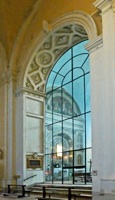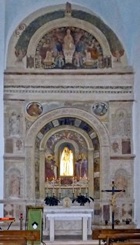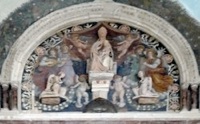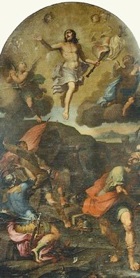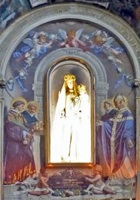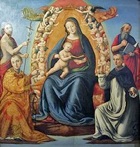The Renaissance arch at the entrance to this chapel off the right wall of San Domenico probably belonged to the Altare di San Lorenzo, which the heirs of Lorenzo di Giovanni Bello commissioned from Agostino di Duccio (see below) in 1459.
Lorenzo's son, Pier Gentile left money in his will for a chapel to be inserted into the wall here, and he entrusted the commission to his heir and aunt, Donna Brigida. The altar by Agostino di Duccio, which had to be demolished to make way for it, was partially re-erected as its altarpiece. The chapel, like the altar, was dedicated to the memory of Pier Gentile's father (Brigida's brother), Lorenzo di Giovanni.
The chapel is now known as the Cappella della Madonna del Voto in reference to the statue (18th century) of the Madonna and Child that is now at the centre of the altarpiece.
Altare di San Lorenzo (1459)
The heirs of Lorenzo di Giovanni Bello commissioned this altar on the back wall of the chapel from
Agostino di Duccio. The contract stipulated the inclusion of statues of the Madonna and Child with SS Laurence, John the Baptist, Peter Martyr and Bridget of Sweden (respectively name saints of the deceased, his father, his grandfather and his sister). The altar was originally located on the last bay of the right wall of the nave of the church, but was demolished in 1482 to permit the construction of the Cappella di San Lorenzo. As noted above, it was partially re-erected as the altarpiece of the new chapel. The arch that now frames the entrance to the chapel (see the illustration above) probably originally framed the altar.
The altarpiece has been altered on a number of occasions. As currently reconstituted, the altar contains a number of figures that are attributed to Agostino di Duccio:
-
✴the Madonna and Child with flanking angels in the lunette;
-
✴stone figures of the Annunciation in the upper niches to the sides (which probably did not belong to the original altar); and
-
✴terracotta figures of SS John the Baptist and Laurence in the lower niches to the sides.
A marble predella panel in which Saint Bridget of Sweden receives the rule of her order, which is attributed to Agostino di Duccio and which almost certainly belonged to the original altar, is now in the Metropolitan Museum, New York.
Frescoes of the Altar (1534)
The altar was refashioned in 1534 when Fra Domenico Baglioni re-dedicated it as the Altare del Rosario. Bernardo di Girolamo Rosselli was commissioned to make a number of alterations to its decoration. Those that survive are:
-
✴the frescoes (1534) in the lunette (illustrated);
-
✴those of prophets in tondi to the sides of the main arch; and
-
✴those under this arch, which depict miracles of the Rosary.
Resurrection (1718)
This panel by
Giuseppe Laudati on the right wall came from the Cappella del Rosario. It is based on a panel (1593) by
Annibale Carracci in San Francesco, Bologna.
Frescoes of the Altar (1869)
These frescoes by
Domenico Bruschi, which surround the Madonna del Voto on the altar, include four full-length figures:
-
✴SS Stephen and Dominic (who holds a model of the church) to the left; and
-
✴the Blessed Tomasello da Perugia (on of the founders of San Domenico) and Pope Benedict XI to the right.
Art from the Chapel
Pala Belli (1493)
This altarpiece, which was recorded in 1683 with an attribution to
Mariano di Ser Austerio, originally formed the altarpiece of an altar on the back wall of chapel. It was almost certainly the work that was the subject of a dispute as to its value between this artist and "Lucretie et Marsilie", which
Giovanni Battista Caporali adjudicated in 1518. These ladies must have been Lucretia Baglioni and Marsilia, respectively the wife and daughter of Antonio, the son of Pier Gentile di Lorenzo Bello. It seems likely therefore that Antonio commissioned the work and then died shortly before the dispute of 1518.
Dominique-Vivant Denon, the Director of the Musée Napoleon (later the Musée du Louvre) selected the main panel for confiscation after the Napoleonic suppression of 1810, and it was duly shipped to Paris. Antonio Canova recovered it in 1815 and it passed to the Pinacoteca Vaticana, Rome. It was exhibited there for many years as a work of unknown provenance attributed to Girolamo Genga, but has recently been recognised as the Pala Belli by Mariano di Ser Austerio.
The surviving panel depicts the Madonna and Child enthroned with SS John the Baptist, Laurence, Dominic and Jerome. The Madonna's throne is set beneath an arch of putti, and two flying angels hold a crown above her head. A predella was also documented in 1810, but this has been lost. It depicted:
-
✴the martyrdom of St Laurence;
-
✴the Deposition of Christ; and
-
✴the Annunciation.


